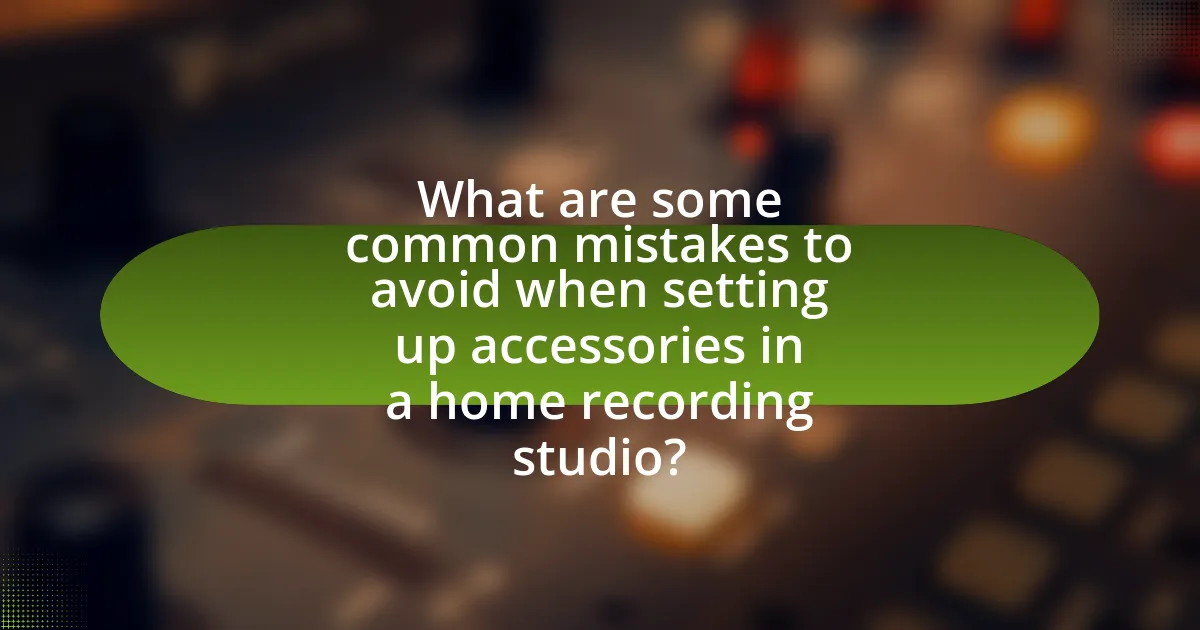The article focuses on the essential accessories for home recording studios, highlighting key components such as audio interfaces, studio monitors, headphones, microphones, and acoustic treatment. It emphasizes the importance of these accessories in enhancing sound quality, improving workflow efficiency, and achieving professional results in music production. The article also discusses specific features to consider when selecting these accessories, the impact of microphone placement and acoustic treatment on recording quality, and common mistakes to avoid in studio setup. Overall, it serves as a comprehensive guide for musicians and producers looking to optimize their home recording environments.

What are the Must-Have Accessories for Home Recording Studios?
The must-have accessories for home recording studios include a quality audio interface, studio monitors, headphones, a microphone, and acoustic treatment. An audio interface is essential for converting analog signals to digital, ensuring high-quality sound capture. Studio monitors provide accurate sound reproduction, which is crucial for mixing and mastering. Headphones are necessary for monitoring recordings without bleed, while a good microphone is vital for capturing vocals and instruments. Acoustic treatment, such as foam panels or bass traps, helps to minimize sound reflections and improve recording quality. These accessories are foundational for achieving professional results in home recording environments.
Why are accessories important in a home recording studio?
Accessories are important in a home recording studio because they enhance the quality of sound production and improve workflow efficiency. Essential accessories such as microphones, audio interfaces, and studio monitors contribute to capturing high-fidelity audio, ensuring accurate sound reproduction, and facilitating seamless integration of various audio components. For instance, a high-quality microphone can significantly affect vocal clarity, while an audio interface allows for better sound conversion and latency reduction, which is crucial for real-time recording. These accessories collectively create an optimal recording environment, enabling musicians and producers to achieve professional results in their projects.
What role do accessories play in enhancing sound quality?
Accessories play a crucial role in enhancing sound quality by improving the overall audio experience through better acoustics, connectivity, and sound isolation. For instance, acoustic panels absorb sound reflections, reducing echo and creating a clearer recording environment. Additionally, high-quality cables minimize signal loss and interference, ensuring that audio fidelity is maintained from source to output. Furthermore, accessories like pop filters and shock mounts prevent unwanted noise and vibrations, contributing to a cleaner sound capture. Studies have shown that proper acoustic treatment can lead to a 50% improvement in sound clarity, demonstrating the significant impact of these accessories on audio quality.
How do accessories contribute to the overall recording experience?
Accessories significantly enhance the overall recording experience by improving sound quality, facilitating ease of use, and providing essential functionality. For instance, high-quality microphones capture clearer audio, while pop filters reduce unwanted noise, ensuring a cleaner recording. Additionally, studio monitors and headphones allow for accurate sound monitoring, which is crucial for mixing and mastering tracks effectively. Research indicates that using the right accessories can lead to a 30% improvement in audio clarity and production efficiency, underscoring their importance in a home recording studio setup.
What types of accessories should every home recording studio have?
Every home recording studio should have essential accessories such as a quality audio interface, studio monitors, headphones, a microphone, and acoustic treatment materials. The audio interface is crucial for converting analog signals to digital, ensuring high-quality recordings. Studio monitors provide accurate sound reproduction, which is vital for mixing and mastering. Headphones are necessary for monitoring recordings without bleed, while a good microphone captures vocals and instruments effectively. Acoustic treatment materials, like foam panels or bass traps, improve sound quality by reducing unwanted reflections and echoes. These accessories collectively enhance the recording experience and ensure professional results.
What are the essential audio interfaces for home studios?
The essential audio interfaces for home studios include the Focusrite Scarlett 2i2, PreSonus AudioBox USB 96, and Universal Audio Apollo Twin. These interfaces are widely recognized for their high-quality preamps, low latency, and compatibility with various digital audio workstations (DAWs). For instance, the Focusrite Scarlett 2i2 features two high-performance mic preamps and is known for its ease of use, making it a popular choice among beginners and professionals alike. The PreSonus AudioBox USB 96 offers solid performance with its 24-bit/96 kHz audio resolution, catering to musicians who require reliable recording capabilities. The Universal Audio Apollo Twin stands out for its real-time UAD processing, allowing users to apply high-quality effects during recording, which is particularly beneficial for professional-grade projects. These interfaces are essential for achieving optimal sound quality and functionality in home recording environments.
How do microphones vary in their suitability for different recording needs?
Microphones vary in their suitability for different recording needs based on their type, polar pattern, frequency response, and intended application. Dynamic microphones are ideal for high sound pressure levels, making them suitable for live performances and loud instruments, while condenser microphones excel in capturing subtle details and are preferred for studio vocals and acoustic instruments. Additionally, microphones with cardioid polar patterns effectively isolate sound from the front, reducing background noise, which is beneficial in untreated recording environments. In contrast, omnidirectional microphones capture sound from all directions, making them suitable for capturing ambient sounds or group recordings. The choice of microphone directly impacts the quality and clarity of the recorded audio, as evidenced by the widespread use of specific types in professional settings tailored to their unique characteristics.
What types of studio monitors are best for accurate sound reproduction?
Active studio monitors are best for accurate sound reproduction. These monitors feature built-in amplifiers and are designed to provide a flat frequency response, which is essential for critical listening and mixing. Brands like Yamaha, KRK, and Adam Audio are known for their high-quality active monitors that minimize coloration of sound, ensuring that audio engineers hear the true representation of their mixes. Studies have shown that monitors with a frequency response range of 20 Hz to 20 kHz, such as the Yamaha HS series, deliver precise sound reproduction, making them ideal for professional audio work.
How can accessories improve workflow in a home recording studio?
Accessories can significantly improve workflow in a home recording studio by enhancing organization, efficiency, and functionality. For instance, using cable management solutions prevents tangling and clutter, allowing for quick access to equipment and reducing setup time. Additionally, microphone stands and pop filters ensure optimal recording conditions, which minimizes the need for extensive post-production editing. Furthermore, studio monitors and acoustic treatment accessories create a more accurate listening environment, enabling better mixing decisions. These improvements lead to a streamlined recording process, ultimately increasing productivity and creativity in music production.
What are the benefits of using MIDI controllers in music production?
MIDI controllers enhance music production by providing intuitive control over software instruments and digital audio workstations (DAWs). They allow musicians to input notes and manipulate sounds in real-time, facilitating a more expressive and dynamic performance. MIDI controllers often feature velocity-sensitive keys, pads, and knobs, which enable nuanced playing and precise adjustments to parameters like volume, effects, and modulation. This versatility streamlines the creative process, making it easier to experiment with different sounds and arrangements. Furthermore, according to a survey by Sound on Sound, 85% of music producers reported increased workflow efficiency when using MIDI controllers, underscoring their importance in modern music production.
How do acoustic treatment panels affect recording quality?
Acoustic treatment panels significantly enhance recording quality by controlling sound reflections and reducing unwanted reverberation in a space. These panels absorb sound waves, preventing them from bouncing off hard surfaces, which can lead to muddiness and phase issues in recordings. Research indicates that properly treated rooms can improve clarity and detail in audio capture, making it easier to achieve a professional sound. For instance, a study by the Acoustical Society of America found that rooms with acoustic treatment can reduce echo by up to 50%, leading to more accurate recordings.

What specific features should you look for in home recording studio accessories?
When selecting home recording studio accessories, prioritize features such as sound quality, compatibility, and durability. High-quality microphones should have a wide frequency response and low self-noise to capture clear audio. Audio interfaces must offer low latency and multiple input/output options to accommodate various recording needs. Additionally, studio monitors should provide accurate sound reproduction, allowing for precise mixing. Cables and stands should be robust and reliable to ensure longevity and optimal performance. These features are essential for creating a professional recording environment that meets industry standards.
How do you choose the right microphone for your recording style?
To choose the right microphone for your recording style, first identify the specific application, such as vocals, instruments, or podcasts. Different microphones, like dynamic, condenser, and ribbon types, serve distinct purposes; for instance, condenser microphones are ideal for capturing vocals due to their sensitivity and wide frequency response, while dynamic microphones excel in live settings and loud sound sources. Additionally, consider the microphone’s polar pattern; cardioid patterns are effective for isolating sound sources, making them suitable for studio recordings. Research indicates that selecting the appropriate microphone can significantly enhance audio quality, as evidenced by a study from the Audio Engineering Society, which found that the right microphone choice can improve clarity and reduce unwanted noise in recordings.
What specifications should you consider when selecting a microphone?
When selecting a microphone, consider specifications such as polar pattern, frequency response, sensitivity, and impedance. The polar pattern determines how the microphone captures sound from different directions, with common types being cardioid, omnidirectional, and bidirectional. Frequency response indicates the range of sound frequencies the microphone can capture, typically measured in Hertz, and affects the clarity and richness of the recorded audio. Sensitivity measures how effectively the microphone converts sound waves into electrical signals, influencing the microphone’s ability to pick up quiet sounds. Impedance affects the compatibility with audio interfaces and mixers, with lower impedance microphones generally being preferred for professional use due to their ability to drive longer cable runs without signal loss. These specifications collectively influence the microphone’s performance and suitability for various recording environments.
How does microphone placement impact recording quality?
Microphone placement significantly impacts recording quality by influencing the capture of sound characteristics, such as clarity, depth, and tonal balance. Proper placement can enhance the direct sound while minimizing unwanted background noise and reflections, leading to a cleaner and more professional recording. For instance, positioning a microphone closer to a sound source increases the signal-to-noise ratio, which improves clarity, while placing it further away can capture ambient sounds, adding depth but potentially reducing clarity. Studies have shown that optimal placement can reduce phase issues and improve frequency response, which are critical for high-quality recordings.
What are the key factors in selecting audio interfaces?
The key factors in selecting audio interfaces include sound quality, connectivity options, latency, and compatibility with software. Sound quality is crucial as it determines the clarity and fidelity of recordings; high-resolution audio interfaces typically support sample rates of 24-bit/192 kHz. Connectivity options, such as USB, Thunderbolt, or MIDI, affect how easily the interface integrates with other equipment. Latency, the delay between input and output, should be minimal for real-time monitoring, ideally under 10 milliseconds. Compatibility with digital audio workstations (DAWs) ensures seamless operation, as some interfaces are optimized for specific software. These factors collectively influence the performance and usability of audio interfaces in home recording studios.
What connectivity options should you prioritize in an audio interface?
You should prioritize USB, XLR, and MIDI connectivity options in an audio interface. USB is essential for connecting to computers and offers high-speed data transfer, making it the most common interface type. XLR inputs are crucial for connecting professional microphones, ensuring high-quality audio capture. MIDI connectivity allows for communication with electronic instruments and software, facilitating music production and performance. These options collectively enhance versatility and compatibility in home recording studios, meeting the needs of various audio sources and devices.
How does latency affect your recording sessions?
Latency negatively impacts recording sessions by causing a delay between the input of sound and its playback, which can disrupt timing and performance. This delay can lead to musicians hearing their own performance out of sync with the backing tracks, making it difficult to maintain rhythm and coherence. Studies indicate that latency above 10 milliseconds can become noticeable and problematic for musicians, affecting their ability to record accurately. For instance, professional audio interfaces typically aim for latency under 5 milliseconds to ensure seamless recording experiences.

What are some common mistakes to avoid when setting up accessories in a home recording studio?
Common mistakes to avoid when setting up accessories in a home recording studio include improper placement of microphones, neglecting acoustic treatment, and using low-quality cables. Improper microphone placement can lead to poor sound capture, as positioning affects the recording quality significantly. Neglecting acoustic treatment results in unwanted reflections and echoes, which can compromise the clarity of recordings. Additionally, using low-quality cables can introduce noise and signal loss, negatively impacting audio fidelity. These mistakes can hinder the overall effectiveness of a home recording studio, making it essential to address them for optimal performance.
What pitfalls should you be aware of when choosing studio monitors?
When choosing studio monitors, be aware of the pitfalls of inaccurate frequency response, poor room acoustics, and inadequate power handling. Inaccurate frequency response can lead to misrepresentation of sound, causing mixing errors; monitors should ideally have a flat response to ensure true sound reproduction. Poor room acoustics can significantly affect monitor performance, as reflections and standing waves can distort audio; treating the room with acoustic panels can mitigate this issue. Inadequate power handling may result in distortion at higher volumes, so selecting monitors with sufficient wattage for your space is crucial. These factors are essential for achieving accurate sound in a home recording studio.
How can improper placement of monitors affect sound quality?
Improper placement of monitors can significantly degrade sound quality by causing issues such as phase cancellation, frequency imbalance, and inaccurate stereo imaging. When monitors are not positioned correctly, sound waves can interact in ways that diminish clarity and detail, leading to a muddled audio experience. For instance, placing monitors too close to walls can result in bass buildup and reflections that alter the perceived sound, while positioning them at incorrect angles can disrupt the stereo field, making it difficult to accurately judge the mix. Research indicates that optimal monitor placement, typically at ear level and forming an equilateral triangle with the listener, enhances sound accuracy and spatial representation, thereby improving overall audio quality.
What are the consequences of neglecting acoustic treatment?
Neglecting acoustic treatment leads to poor sound quality and increased noise interference in recording environments. Without proper acoustic treatment, sound waves can reflect off hard surfaces, causing echoes and muddiness in recordings. This results in a less professional sound, making it difficult to achieve clarity and balance in audio tracks. Studies show that untreated rooms can have a significant impact on frequency response, with variations of up to 20 dB in certain ranges, which can distort the intended sound. Consequently, musicians and audio engineers may struggle to produce high-quality recordings, ultimately affecting the overall success of their projects.
What tips can help you maximize the effectiveness of your home recording studio accessories?
To maximize the effectiveness of your home recording studio accessories, ensure proper placement and acoustic treatment of your space. Proper placement of microphones, monitors, and instruments can significantly enhance sound quality; for instance, positioning monitors at ear level and away from walls reduces unwanted reflections. Acoustic treatment, such as using foam panels or bass traps, minimizes echo and improves clarity, which is essential for accurate mixing. Additionally, regularly maintaining your equipment, such as cleaning microphones and checking cables for wear, ensures optimal performance and longevity. These practices are supported by audio engineering principles that emphasize the importance of environment and equipment care in achieving high-quality recordings.
How can regular maintenance improve the longevity of your equipment?
Regular maintenance significantly improves the longevity of your equipment by ensuring optimal performance and preventing wear and tear. Consistent upkeep, such as cleaning, lubrication, and timely repairs, minimizes the risk of breakdowns and extends the operational lifespan of components. For instance, a study by the National Institute of Standards and Technology found that regular maintenance can increase equipment lifespan by up to 30%, demonstrating the tangible benefits of proactive care.
What best practices should you follow for organizing your studio space?
To effectively organize your studio space, prioritize functionality, accessibility, and cleanliness. Begin by designating specific areas for different activities, such as recording, mixing, and editing, to streamline workflow. Utilize storage solutions like shelves, bins, and racks to keep equipment and materials organized and easily accessible. Label all items and storage areas to enhance efficiency and reduce time spent searching for tools. Additionally, maintain a clutter-free environment by regularly decluttering and cleaning the space, which can improve focus and creativity. Studies show that organized workspaces can lead to increased productivity, highlighting the importance of these practices in a home recording studio.



